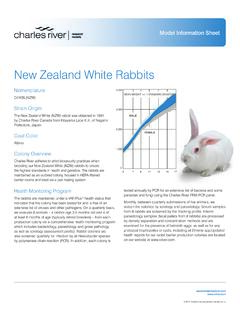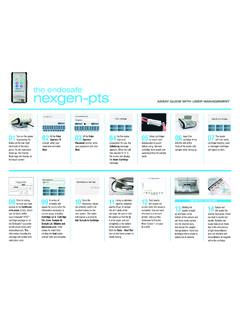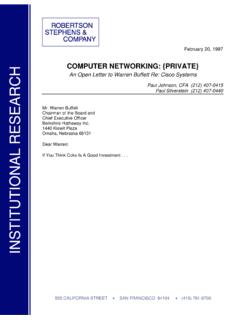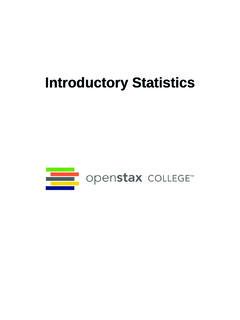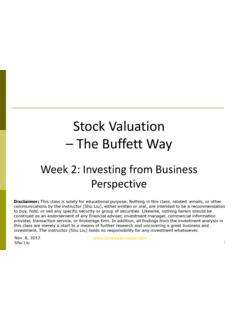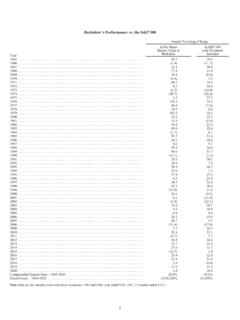Transcription of GENERAL TOXICOLOGY: NON-RODENT SPECIES IN SAFETY …
1 GENERAL TOXICOLOGY: NON-RODENT SPECIES IN SAFETY STUDIES AND PLANNING CARCINOGENICITY STUDIESW arren HarveyBSc MSc IDT DABT CBiol MRSB ERTEVERY STEP OF THE WAYOUTLINE2 EVERY STEP OF THE WAY Brief overview of non rodent SPECIES Small molecules Biologicals Brief overview of planning a carcinogenicity study Planning and study design considerations Transgenic mouse modelTHE TOXICOLOGIST WILL SEARCH FOR THE UNEXPECTEDEVERY STEP OF THE WAY3 DRUG DISCOVERY AND DEVELOPMENTThe Roller Coaster Ride to the Clinic!How are drugs discovered and developed?EVERY STEP OF THE WAY4 NON-CLINICAL DRUG SAFETY EVALUATIONFor small molecules and biological products the principles remain the same SAFETY of the volunteer or patientWhat are we trying to achieve?EVERY STEP OF THE WAY5 GOALS OF NON-CLINICAL SAFETY TESTINGC haracterisation of toxicity Identify target organs Dose dependence and relationship to exposure (toxicokinetics)Risk assessment SAFETY margins between toxicology and efficacy studies Monitorability and reversibility of the observed toxicity Mechanism of toxicity Relevance to humans Relationship to pharmacologyGuidance for clinical trials Studies designed to characterise potential adverse effects that might occur in the clinical trial to be supported Duration Same route of administration Estimation of a safe starting dose & guide dose escalation Parameters for clinical monitoringEVERY STEP OF THE WAY6 RISK COMES FROM NOT KNOWING WHAT YOU RE DOING!
2 7 warren BuffettEVERY STEP OF THE WAYREGULATORY GUIDELINESR egulatory guidelines are like the London Underground!There is almost always more than one way to reach an objective and the recommended route might not be the one you should follow!Guidelines are generally written in order to provide an element of flexibility and not to place undue legislative restraints on scientific progressNEVER FOLLOW A REGULATORY GUIDELINE IF THERE IS A GOOD SCIENTIFIC RATIONALE NOT TO! GOOD SCIENCE IS FAR MORE IMPORTANT THAN A RIGOROUS ADHERENCE TO A GUIDELINEEVERY STEP OF THE WAY8 ICH Harmonised Tripartite Guidelines ( ) M3 (R2) GUIDANCE ON NONCLINICAL SAFETY STUDIES FOR THE CONDUCT OF HUMAN CLINICAL TRIALS AND MARKETING AUTHORIZATION FOR PHARMACEUTICALS S1A GUIDELINE ON THE NEED FOR CARCINOGENICITYSTUDIES OF PHARMACEUTICALS S1B TESTING FOR CARCINOGENICITY OF PHARMACEUTICALS S1C DOSE SELECTION FOR CARCINOGENICITY STUDIES OF PHARMACEUTICALS S2 (R1) GUIDANCE ONGENOTOXICITYTESTING AND DATA INTERPRETATION FOR PHARMACEUTICALS INTENDED FOR HUMAN USE S3A NOTE FOR GUIDANCE ONTOXICOKINETICS.
3 THE ASSESSMENT OF SYSTEMIC EXPOSURE IN TOXICITY STUDIES S3B GUIDANCE FOR REPEATED DOSE TISSUE DISTRIBUTION STUDIES S4 DURATION OF CHRONIC TOXICITYTESTING IN ANIMALS (RODENT AND ON RODENT TOXICITY TESTING) S5 (R2) DETECTION OF TOXICITY TOREPRODUCTIONFOR MEDICINAL PRODUCTS & TOXICITY TO MALE FERTILITY S6 (R1) PRECLINICAL SAFETY EVALUATION OFBIOTECHNOLOGY DERIVED PHARMACEUTICALS S7A SAFETY PHARMACOLOGY STUDIES FOR HUMAN PHARMACEUTICALS S7B THE NON CLINICAL EVALUATION OF THE POTENTIAL FOR DELAYED VENTRICULAR REPOLARIZATION (QT INTERVAL PROLONGATION) BY HUMAN PHARMACEUTICALS S8 IMMUNOTOXICITYSTUDIES FOR HUMAN PHARMACEUTICALS S9 NONCLINICAL EVALUATION FOR ANTICANCERPHARMACEUTICALS S10 PHOTOSAFETYEVALUATION OF PHARMACEUTICALSREGULATORY GUIDELINESEVERY STEP OF THE WAY9 NON-RODENT SPECIES in SAFETY StudiesSMALL MOLECULES AND BIOLOGICALS ARE DIFFERENT 12 Small Molecules Chemically synthesized Low molecular weight <1kDa May be metabolised to toxic intermediate Usually not immunogenic Can interact with multiple cells or organs Generally active in many speciesBiologicals Derived from living cells High molecular weight >5kDa Degraded to non toxic amino acids or peptides May initiate immune response to foreign protein Usually highly targeted to specific cellular receptors Activity often limited to SPECIES possessing relevant receptors/mechanism of actionToxicity often off targetToxicityoften exaggerated pharmacologyEVERY STEP OF THE WAYPROTEIN THERAPEUTICS BIOLOGICS Current generationRecombinant proteins (hormones.)
4 Cytokines, growth factors, clotting ), pegylated proteins, antibodies (mAbs), antibody fragments ( Fabs), antibody drug conjugates (ADCs)Next generation Engineered antibodies, bispecifics, ADCs, antibody fragments and related products, above proteins with non natural amino acids / post translational modifications ( altered glycosylation pattern), new protein scaffolds ( fibronectins, anticalins, fynomers, ..)EVERY STEP OF THE WAY12 SPECIES SELECTION11 EVERY STEP OF THE WAYThe challenge !!!CONSIDERATIONS SELECTING ANIMAL SPECIES Pharmacologically responsive? To address concerns around exaggerated pharmacologyAppropriate local and systemic exposure to the drug Ensure adequate exposure margins in the relevant tissues/compartmentsis achievable using the proposed route of administration in man Supplement by alternative route if needed and feasible Take into account local vs systemic exposure, half life, exposure profiles, max/min levels, protein binding etc. Coverage of human relevant metabolites?
5 Compare cross SPECIES man Microsomes Hepatocytes In vivo dataSmall moleculesEVERY STEP OF THE WAY14 CONSIDERATIONS SELECTING ANIMAL SPECIES Tissue and SPECIES specificity of target pathway biology Target specificity, potency and off target potential Characterising PK/PD Predicting SAFETY liabilities Opportunity for new indicationsKey drivers of comparative biologyEVERY STEP OF THE WAY15 Comparative Biology at Molecular, Biochemical, Cellular and Tissue LevelsTarget/ Pathway BiologyPK/PDGenome EpigenomeTranscriptomeADMEL ocalisationIntegration of gene sequence, gene expression ( splice variants, post translational modifications, sub-cellular localisation) and endogenous protein interactions & functions ( cofactors, enzyme activity) at molecular/ biochemical/cellular/tissue levels (Adapted from J Moggs, Novartis)MinipigDogCynomolgus, Marmoset,RhesusRatHamsterRabbitMouseEVER Y STEP OF THE WAY16 HOW TO SELECT THE APPROPRIATE SPECIES FOR SAFETY ASSESSMENT?
6 ICH S6 (R1) Addendum A number of factors should be taken into account when determining SPECIES relevancy. Comparisons of target sequence homology between SPECIES can be an appropriate starting point, followed by in vitro assays to make qualitative and quantitative cross SPECIES comparisons of relative target binding affinities and receptor/ligand occupancy and kinetics. Assessments of functional activity are also recommended. Functional activity can be demonstrated in SPECIES specificcell based systems and/or in vivo pharmacology or toxicology studies. Modulation of a known biologic response or of a pharmacodynamic (PD) marker can provide evidence for functional activity to support SPECIES relevance. Consideration of SPECIES differences in target binding and functional activity in the context of the intended dosing regime should provide confidence that a model is capable of demonstrating potentially adverse consequences of target modulation. When the target is expressed at very low levels in typical healthy preclinical SPECIES ( , inflammatory cytokines or tumorantigens), binding affinity and activity in cell based systems can be sufficient to guide SPECIES selection.
7 Large molecules BiologicalsEVERY STEP OF THE WAY17 REGULATORY TOXICOLOGY TESTING FOR BIOLOGICALS18 EVERY STEP OF THE WAYAn overviewICH S6 (R1) guideline recognises that conventional approaches to toxicity studies used for small molecule drugs are often NOTappropriate for biologicalsDoes NOTprovide a one size fits all or cookbook approach to toxicology study design Provides a framework for design of animal studies to address SAFETY of biotechnology derived products, based on characteristics of the product and intended clinical usePilot Studies: Early De risking Strategy Conduct two phase pilots Single dose and repeat dose DRF Enriched design with clinical pathology, PK, biomarkers (limited or full pathology evaluation) Determine the (lower dose) MTD Learned toxicity may be cumulativeAllow time for pilot data analysis in program plansUse data to refine and de risk GLP plansPRECLINICAL STUDIES FOR SMALL MOLECULES18 Genotoxicity Ames test (mutagenicity only sufficient for single dose clinical trials) Chromosome aberration or mouse lymphoma Rodent Micronucleus AssayRepeat dose toxicology (rodent and non rodent) Rat single dose and 7 day dose range finding toxicity study Non rodent maximum tolerated repeat dose study (MTD) 14 or 28 day rat toxicity study including TK 14 or 28 day non rodent toxicity study including TKSafety pharmacology (ICH S7A and S7B) hERG cardio electrophysiology study Cardiovascular telemetry study Irwin Screen or Functional Observational Battery (FOB)
8 ADME Confirmation of SPECIES suitability ( in vitro metabolic profiling) Plasma/RBC binding study (to put hERG results into context)EVERY STEP OF THE WAY20 Target SelectionLead generation & optimisationCandidate drug (CD) prenominationREGULATORY TOXICOLOGY TESTING FOR SMALL MOLECULESP hase IPhase IIPhase IIIGLP Toxicology Phase GENERAL toxicology (ICH M3 (R2), S9, S4) Target/chemistry issues bespoke approaches SAFETY Pharmacology (ICH S7) Core battery: Cardiovascular, CNS, Respiratory + follow up/ supplemental studies as needed Genetic toxicology & Carcinogenicity (ICH S2 (R2) & S1) Reproductive toxicology (ICH S5 (R2)) DevelopmentDiscoveryRodentNonRodentMTD/D RFMTD/DRFOne month + recoveryOne month + recoveryChronicChronicSAR, Ames, MOLY, Micronucleus CarcinogenicityEFD Fertility P & PAn overview COMMONLY USED SPECIES IN TOXICOLOGYD omestic Rabbit (Oryctolagus cuniculus) New Zealand White Rabbit most common Dutch Belted Rabbit has pigmented skin and eye Non rodent animal model Reproductive toxicology Ocular toxicology Vascular irritationEVERY STEP OF THE WAY21 COMMONLY USED SPECIES IN TOXICOLOGY Minipig breeds G ttingen minipig Yucatan minipig Hanford minipig Sinclair minipig Cardiology Dermal toxicology Organ transplantation and surgical researchPig (Sus scrofa)
9 EVERY STEP OF THE WAY22 COMMONLY USED SPECIES IN TOXICOLOGY Most widely used non rodent research animal Cardiovascular and circulatory research Oncology research Extensive historical database for small molecule development Organ transplantation Pressures to limit useDomesticated Dog (Canis familiaris)EVERY STEP OF THE WAY23 SPECIES SELECTION Phylogenetic and physiologic homology with humans Marmoset and rhesus monkey occasionally used Pharmacological activity of biologicals in monkeys often resembles that in humans than dogs, rabbits and rodents Primate immune system is similar to humans Biologicals less immunogenic following chronic dosing in primates than lower SPECIES Antigenicity of humanised protein therapeutics decreased Old and New World SPECIES Differences in physiology need to be considered Costly and limited resource Scientific justification for useNon human primate (NHP)NHP identified as most suitable and relevant toxicology NON-RODENT SPECIES for biologicalsEVERY STEP OF THE WAY2410 subspecies of cynomolgus.
10 Crab eating Macaque, Macaca fascicularis fascicularis, synonym Macaca irus Burmese Long tailed Macaque, Macaca fascicularis aurea Nicobar Long tailed Macaque, Macaca fascicularis umbrosa Dark crowned Long tailed Macaque, Macaca fascicularis atriceps Con Song Long tailed Macaque, Macaca fascicularis condorensis Simeulue Long tailed Macaque, Macaca fascicularis fusca Lasia Long tailed Macaque, Macaca fascicularis lasiae Maratua Long tailed Macaque, Macaca fascicularis tua Kemujan Long tailed Macaque, Macaca fascicularis karimondjawae Philippine Long tailed Macaque, Macaca fascicularis philippinensisIMPORTANT MONKEY BUSINESS Protein Sequence Differences between SPECIES / SubspeciesWhile the differences between SPECIES are intuitive, there are also variations between subspecies but even between races or breeds as a result of geographical distribution or STEP OF THE WAY25 Carcinogenicity PlanningCARCINOGENICITY TESTING27 EVERY STEP OF THE WAYThe objectives of carcinogenicity studies Identification of carcinogenic properties of a test item Identification of target organs Characterisation of dose response relationship Identification of NOEL or NOAEL Prediction of carcinogenic effects of test item at human dose levelsCARCINOGENICITY TESTINGO verview Studies in rodents with life time exposure ~ 2 years Expense (up to 1 million per bioassay) depends on complexity of study Usually rats and mice (2 studies) Large number of animals required ( 480 animals/study) Tumour incidence histopathological evaluation of most tissues Duration between study initiation and final report (~3 years)







